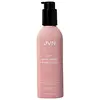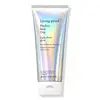What's inside
What's inside
 Key Ingredients
Key Ingredients

 Benefits
Benefits

 Concerns
Concerns

 Ingredients Side-by-side
Ingredients Side-by-side

Water
Skin ConditioningGlycerin
HumectantHeptyl Glucoside
Oryza Sativa Extract
AbsorbentHydroxypropyltrimonium Hydrolyzed Rice Protein/Siloxysilicate
Leuconostoc/Radish Root Ferment Filtrate
AntimicrobialAspergillus Ferment
Skin ConditioningArginine
MaskingC13-15 Alkane
SolventSalvia Hispanica Seed Extract
EmollientGlycine
BufferingAlanine
MaskingSerine
MaskingValine
MaskingIsoleucine
Skin ConditioningProline
Skin ConditioningThreonine
Histidine
HumectantPhenylalanine
MaskingBrassicamidopropyl Dimethylamine
Skin ConditioningXylitylglucoside
HumectantAnhydroxylitol
HumectantMaltitol
HumectantPelvetia Canaliculata Extract
Skin ProtectingHydroxypropyl Methylcellulose
Emulsion StabilisingGuar Hydroxypropyltrimonium Chloride
Skin ConditioningEthylhexylglycerin
Skin ConditioningXylitol
HumectantAspartic Acid
MaskingSodium PCA
HumectantSodium Lactate
BufferingPCA
HumectantSodium Hydroxide
BufferingTocopherol
AntioxidantBenzyl Alcohol
PerfumingSorbic Acid
PreservativeSodium Benzoate
MaskingParfum
MaskingPhenoxyethanol
PreservativeLimonene
PerfumingLinalool
PerfumingCitrus Aurantium Bergamia Fruit Extract
Skin ConditioningCitrus Limon Peel Oil
Masking2,4-Dimethyl-3-Cyclohexene Carboxaldehyde
MaskingCis-3-Hexenyl Methyl Carbonate
PerfumingLavandula Angustifolia Oil
MaskingEthyl Linalool
MaskingTerpineol
Masking2-T-Butylcyclohexyl Acetate
MaskingNeryl Acetate
PerfumingAlpha-Damascone
MaskingGamma-Undecalactone
PerfumingMethyldihydrojasmonate
MaskingGeranyl Acetate
PerfumingTetramethyl Acetyloctahydronaphthalenes
Masking1-Naphthol
Ethylene Brassylate
MaskingC13-16 Isoparaffin
SolventWater, Glycerin, Heptyl Glucoside, Oryza Sativa Extract, Hydroxypropyltrimonium Hydrolyzed Rice Protein/Siloxysilicate, Leuconostoc/Radish Root Ferment Filtrate, Aspergillus Ferment, Arginine, C13-15 Alkane, Salvia Hispanica Seed Extract, Glycine, Alanine, Serine, Valine, Isoleucine, Proline, Threonine, Histidine, Phenylalanine, Brassicamidopropyl Dimethylamine, Xylitylglucoside, Anhydroxylitol, Maltitol, Pelvetia Canaliculata Extract, Hydroxypropyl Methylcellulose, Guar Hydroxypropyltrimonium Chloride, Ethylhexylglycerin, Xylitol, Aspartic Acid, Sodium PCA, Sodium Lactate, PCA, Sodium Hydroxide, Tocopherol, Benzyl Alcohol, Sorbic Acid, Sodium Benzoate, Parfum, Phenoxyethanol, Limonene, Linalool, Citrus Aurantium Bergamia Fruit Extract, Citrus Limon Peel Oil, 2,4-Dimethyl-3-Cyclohexene Carboxaldehyde, Cis-3-Hexenyl Methyl Carbonate, Lavandula Angustifolia Oil, Ethyl Linalool, Terpineol, 2-T-Butylcyclohexyl Acetate, Neryl Acetate, Alpha-Damascone, Gamma-Undecalactone, Methyldihydrojasmonate, Geranyl Acetate, Tetramethyl Acetyloctahydronaphthalenes, 1-Naphthol, Ethylene Brassylate, C13-16 Isoparaffin
Water
Skin ConditioningJojoba Esters
EmollientCetearyl Alcohol
EmollientPolycitronellol T-Butyl Ether
EmollientPolyglyceryl-10 Decaoleate
Skin ConditioningIsopentyldiol
HumectantGlycerin
HumectantC10-18 Triglycerides
EmollientSodium Hyaluronate
HumectantFructose
HumectantStearamidopropyl Dimethylamine
EmulsifyingBehenamidopropyl Dimethylamine
EmulsifyingVerbascum Thapsus Extract
Skin ConditioningPolyporus Umbellatus Extract
Skin ProtectingPhytosteryl/Octyldodecyl Lauroyl Glutamate
Skin ConditioningLauryl/Myristyl Polyricinoleate
EmollientPolyquaternium-11
Hydroxypropyl Methylcellulose
Emulsion StabilisingCaesalpinia Spinosa Gum
Skin ConditioningHydroxyethylcellulose
Emulsion StabilisingCetyl Alcohol
EmollientBis-(Isostearoyl/Oleoyl Isopropyl) Dimonium Methosulfate
Skin ConditioningGlyceryl Stearate
EmollientSteareth-20
CleansingCeteth-20
CleansingPEG-75 Stearate
Parfum
MaskingLactic Acid
BufferingSodium Citrate
BufferingPentylene Glycol
Skin ConditioningHydroxyacetophenone
AntioxidantEthylhexylglycerin
Skin ConditioningLimonene
PerfumingHexyl Cinnamal
PerfumingLinalool
PerfumingCitronellol
PerfumingWater, Jojoba Esters, Cetearyl Alcohol, Polycitronellol T-Butyl Ether, Polyglyceryl-10 Decaoleate, Isopentyldiol, Glycerin, C10-18 Triglycerides, Sodium Hyaluronate, Fructose, Stearamidopropyl Dimethylamine, Behenamidopropyl Dimethylamine, Verbascum Thapsus Extract, Polyporus Umbellatus Extract, Phytosteryl/Octyldodecyl Lauroyl Glutamate, Lauryl/Myristyl Polyricinoleate, Polyquaternium-11, Hydroxypropyl Methylcellulose, Caesalpinia Spinosa Gum, Hydroxyethylcellulose, Cetyl Alcohol, Bis-(Isostearoyl/Oleoyl Isopropyl) Dimonium Methosulfate, Glyceryl Stearate, Steareth-20, Ceteth-20, PEG-75 Stearate, Parfum, Lactic Acid, Sodium Citrate, Pentylene Glycol, Hydroxyacetophenone, Ethylhexylglycerin, Limonene, Hexyl Cinnamal, Linalool, Citronellol
Alternatives
Ingredients Explained
These ingredients are found in both products.
Ingredients higher up in an ingredient list are typically present in a larger amount.
Ethylhexylglycerin (we can't pronounce this either) is commonly used as a preservative and skin softener. It is derived from glyceryl.
You might see Ethylhexylglycerin often paired with other preservatives such as phenoxyethanol. Ethylhexylglycerin has been found to increase the effectiveness of these other preservatives.
Glycerin is already naturally found in your skin. It helps moisturize and protect your skin.
A study from 2016 found glycerin to be more effective as a humectant than AHAs and hyaluronic acid.
As a humectant, it helps the skin stay hydrated by pulling moisture to your skin. The low molecular weight of glycerin allows it to pull moisture into the deeper layers of your skin.
Hydrated skin improves your skin barrier; Your skin barrier helps protect against irritants and bacteria.
Glycerin has also been found to have antimicrobial and antiviral properties. Due to these properties, glycerin is often used in wound and burn treatments.
In cosmetics, glycerin is usually derived from plants such as soybean or palm. However, it can also be sourced from animals, such as tallow or animal fat.
This ingredient is organic, colorless, odorless, and non-toxic.
Glycerin is the name for this ingredient in American English. British English uses Glycerol/Glycerine.
Learn more about GlycerinThis ingredient is a semi-synthetic polymer created from cellulose. In case you need a refresher, cellulose is the main component of plant cell walls.
Hydroxypropyl Methylcellulose has many uses:
- emulsifier
- create a gel-like texture
- boost foam
Limonene is a fragrance that adds scent and taste to a formulation.
It's found in the peel oil of citrus fruits and other plants such as lavender and eucalyptus. The scent of limonene is generally described as "sweet citrus".
Limonene acts as an antioxidant, meaning it helps neutralize free radicals.
When exposed to air, oxidized limonene may sensitize the skin. Because of this, limonene is often avoided by people with sensitive skin.
The term 'fragrance' is not regulated in many countries. In many cases, it is up to the brand to define this term. For instance, many brands choose to label themselves as "fragrance-free" because they are not using synthetic fragrances. However, their products may still contain ingredients such as essential oils that are considered a fragrance.
Learn more about LimoneneLinalool is a fragrance and helps add scent to products. It's derived from common plants such as cinnamon, mint, citrus, and lavender.
Like Limonene, this ingredient oxidizes when exposed to air. Oxidized linalool can cause allergies and skin sensitivity.
This ingredient has a scent that is floral, spicy tropical, and citrus-like.
Learn more about LinaloolParfum is a catch-all term for an ingredient or more that is used to give a scent to products.
Also called "fragrance", this ingredient can be a blend of hundreds of chemicals or plant oils. This means every product with "fragrance" or "parfum" in the ingredients list is a different mixture.
For instance, Habanolide is a proprietary trade name for a specific aroma chemical. When used as a fragrance ingredient in cosmetics, most aroma chemicals fall under the broad labeling category of “FRAGRANCE” or “PARFUM” according to EU and US regulations.
The term 'parfum' or 'fragrance' is not regulated in many countries. In many cases, it is up to the brand to define this term.
For instance, many brands choose to label themselves as "fragrance-free" because they are not using synthetic fragrances. However, their products may still contain ingredients such as essential oils that are considered a fragrance by INCI standards.
One example is Calendula flower extract. Calendula is an essential oil that still imparts a scent or 'fragrance'.
Depending on the blend, the ingredients in the mixture can cause allergies and sensitivities on the skin. Some ingredients that are known EU allergens include linalool and citronellol.
Parfum can also be used to mask or cover an unpleasant scent.
The bottom line is: not all fragrances/parfum/ingredients are created equally. If you are worried about fragrances, we recommend taking a closer look at an ingredient. And of course, we always recommend speaking with a professional.
Learn more about ParfumWater. It's the most common cosmetic ingredient of all. You'll usually see it at the top of ingredient lists, meaning that it makes up the largest part of the product.
So why is it so popular? Water most often acts as a solvent - this means that it helps dissolve other ingredients into the formulation.
You'll also recognize water as that liquid we all need to stay alive. If you see this, drink a glass of water. Stay hydrated!
Learn more about Water